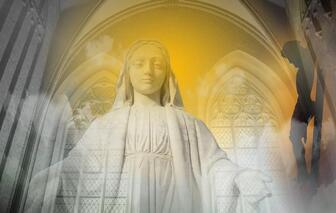 By M.P. Pellicer | Stranger Than Fiction Stories It was Labor Day weekend and Steve Liethen owner of the Good 'N Loud Music in Dane County, Wisconsin was fixing a water leak after a boiler was removed. When he shone a light into the chimney the last thing he expected to see was a human skull. 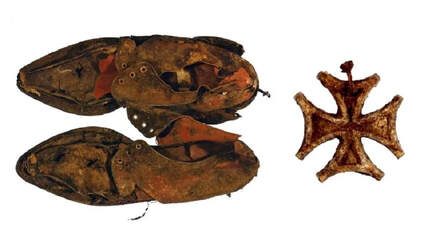 Shoes and iron cross found with the bones in the chimney Shoes and iron cross found with the bones in the chimney Dane County, Wisconsin, September 3, 1989 A construction crew made a hole at the base of the chimney to remove the remains. They also found a shoe, pieces of clothing and a 6-inch clump of intact reddish-brown hair. Early on it was determined the skeleton belonged to a man ranging in age from 18 to 30 years. It was estimated he had been there about two years or as recently as 2 months. He was Caucasian, 5'5" tall with a small build, brownish hair and a pronounced overbite. Later on his probable age was amended to 22 to 27. 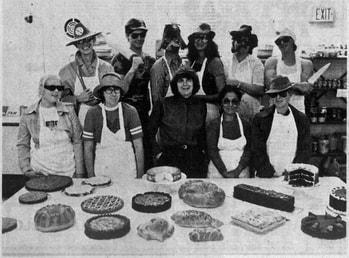 The owner of The Pastry Cart with her mystery bakers was the last business in the space before the music shop c.1984 (Source - Wisconsin State Journal) The owner of The Pastry Cart with her mystery bakers was the last business in the space before the music shop c.1984 (Source - Wisconsin State Journal) The building was constructed in the 1960s, and prior to the music store, The Pastry Cart, a bakery rented the space. Before that there had been The Bread Shop a Christian bookstore. It was believed any smell coming from the decomposing body would have been vented through the chimney, which rose about 6 or 7 feet above the store, or the smells from the bakery would have helped to mask the odor. The building sat vacant from December 1988 to April 1989, until Good n' Loud bought the space, however it remained unoccupied until their grand opening in August, 1989. Then the case took a strange twist when it was discovered that man was dressed like a woman. He was wearing a sleeveless paisley dress with a matching belt, a long-sleeved, button-down shirt, a medium sized White Stag brand shaggy pile sweater, and pointy low-heeled women's shoes. He was wearing one pair of ankle socks and carried another pair, however he was not wearing underwear, a bra or undershirt. Detectives also found a German iron cross medallion, a butter knife and a pocket comb. An anthropologist from UW-Madison confirmed the remains belonged to a man. 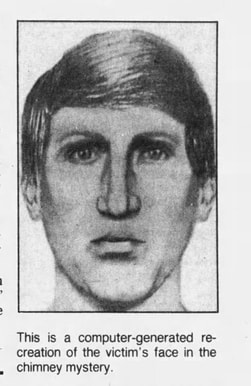 Computer generated facial reconstruction of the man in the chimney c.1990 Computer generated facial reconstruction of the man in the chimney c.1990 Authorities suspected the person may have been a cross dresser, or for some reason was disguising himself as a woman. In November 1989, the case was televised nationwide on Hard Copy. Police had run out of leads, and there were no missing person reports that corresponded with this person. It was around this time that police released other information about the body. The victim's pelvic bone had two breaks in it, which was theorized happened before he died. The bones had no other injuries. Police believed he was prostituting himself, and was killed by a maddened attacker after it was discovered he was not a woman. To get into the chimney base, the body was stuffed feet first down a pipe measuring 11 3/4 inches. He was either dead or unconscious when shoved in there. That he actually jumped in and got stuck in a bungled burglary scenario, would be the most remote version of how this man ended up in there. Plus why would anyone break into a bakery, since the music shop had not opened yet?  Facial reconstruction of the man found at the bottom of the chimney in 1989 Facial reconstruction of the man found at the bottom of the chimney in 1989 In 1990, the results of a reconstruction by the Smithsonian Institution was displayed. By then the police had not been able to identify him, despite the nationwide exposure given by Hard Copy. Dental records were checked, as well as missing persons files, and no match could be found. Most disturbing was no one came forward to identify who this person was. The closest explanation was that he was transient, and had not been long in the area. Police showed pictures of the reconstruction to dozens of people who worked in the building up to two years before the bones were found, to see if he was a former employee or an area resident. No one recognized him. 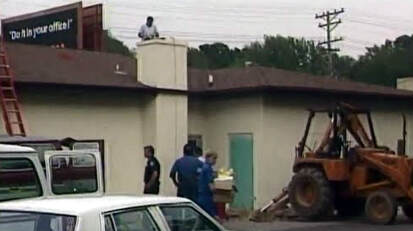 Exterior of the building where the body was found in the chimney c.1989 Exterior of the building where the body was found in the chimney c.1989 Police noted the chimney was not visible from any road running through the area, so the victim or the attacker was familiar with the neighborhood, and was not a place where someone would dump a body in a hasty effort to get rid of it. This opening was on the rooftop of the building, and the clay-lined chimney extended downward for 27 feet. Liethen, the owner of Good n' Loud provided detectives at the time of the initial investigation photos when the building was for sale, which showed old appliances stacked against the back wall which would have acted as an improvised ladder. The police at best suspected there was some association with the building and the body, theorizing it would have been easier to get rid of the remains in a dumpster, then shove it down the narrow aperture. 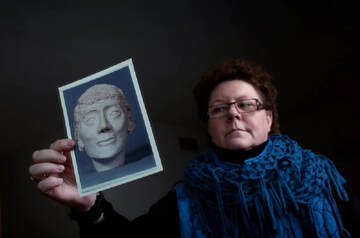 Laura Zimmerman with photo of reconstructed skull c.2012 (Source - Wisconsin State Journal) Laura Zimmerman with photo of reconstructed skull c.2012 (Source - Wisconsin State Journal) In 2012, George Hesselberg a writer for the Wisconsin State Journal received a tip. He had been writing a yearly commentary on the skeleton in the chimney up until 2003. Laura Zimmerman who had just retired, said that in 1990 she was working in the Senate Sergeant at Arms office when she saw the rendition of the man in the chimney, which appeared in the newspaper. She said she recognized the face as belonging to one of the capital pages, and even made a comment to the Sergeant at Arms. He didn't recognize it, but there were from 30 to 40 pages on staff at the time. Hesselberg called police who in turn listened to Zimmerman's story. They circulated the photos of the reconstructed skull to staff and interns from that time period. No one recognized the man. In 2018, a new detective was given the case, and in conjunction with DNA Doe Project, the rootless hair sample was given over to a laboratory in 2021. The hope of course is that they can retrieve a DNA profile which would be matched to a living relative. As of 2022 they are still working on it. Since then the building on University Avenue in Madison has been demolished, and turned into a coffee shop. It's an open case, contact City of Madison Police Department at 608-229-8215 with any information Another Skeleton in the Chimney Joseph Wayne Schexnider, LA Natl Guard c.1980 Joseph Wayne Schexnider, LA Natl Guard c.1980 This is not the first time, a chimney became a tomb for a human, and left more questions than answers. Five years before the discovery was made in Madison, Wisconsin, Joseph Wayne Schexnider, 22, was last seen by his family in January, 1984. He was to appear in district court on a charge of possession of a stolen vehicle, but never showed up. When the sheriff came to the family's residence the mother told deputies he had run off to avoid the court proceedings. 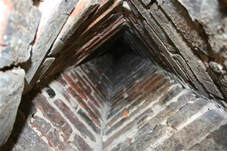 Joseph Schexnider's body was found inside this chimney (Source - Abbeville Police Dept) Joseph Schexnider's body was found inside this chimney (Source - Abbeville Police Dept) Known as a wanderer, Schexnider first ran off when he was 9 or 10 years old. He dropped out of high school in the ninth grade. In 1978, when he was 17 years old his mother placed an announcement in the local newspaper to report him missing with a description. She ran the ad every week for a whole month. It seemed that her son made a habit of going on "walkabout" and would return eventually. He served briefly in the Louisiana National Guard, and completed training in July, 1980 at Fort Leonard Wood in Missouri. It was noted his wife Melinda, and his mother Eula Breaux lived in Abbeville. Eventually he left with a medical discharge. When he dropped from sight in 1984, he was not reported missing by his family since they thought he would turn up eventually like he had done other times. His mother was worried, but his brother Robert reminded her of Joe's penchant for disappearing for a time. He once told one of his brothers he had seen every state in the country. He followed carnivals and once traveled with a circus selling cotton candy and peanuts. Friends who grew up with him described him as simple and quiet. 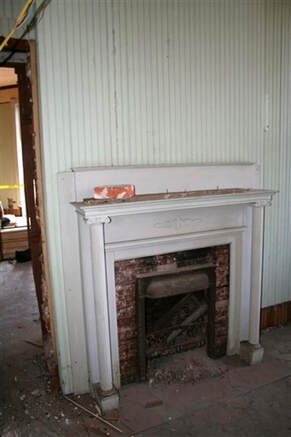 Bank of Abbeville fireplace on the 2nd floor c.2011 Bank of Abbeville fireplace on the 2nd floor c.2011 Months became years until May, 2011 when a strange discovery was made in the local bank's chimney. The vacant second floor of the building was being converted into offices when a construction worker tugged on fabric coming out of the chimney. It dislodged bones and old clothes. The person in the chimney was wearing a yellow long-sleeve shirt, a pair of jeans, blue tennis shoes and jockey shorts with his surname printed on the waistband. There was also gloves, a magazine, a watch, a cigarette lighter and a wallet with his birth certificate and Social Security card, which left little doubt about his identity. There were no signs of foul play as far the bones were concerned, and police explained that without soft tissue it would be impossible to determine if he had met with foul play. A DNA test confirmed his identity. Schexnider had gone into a 14-inch x 14-inch chimney feet first. This opening narrowed towards the end, where it opened into a small fireplace on the second floor. If he had gone in there alive it would have been hard for anyone to hear him, as he was 20 feet above the street surrounded by brick. No one working on the first floor reported strange noises or smells, and the second floor was used only for storage. Ironically in 1987, the chimneys in Abbeville's downtown were capped, but no one noticed what was left of Schexnider inside the one belonging to the Bank of Abbeville. His brother had no answers as to why his brother was in the chimney, but admitted that before he disappeared he was hanging out "with a bad crowd." There were no burglary tools with the remains.
0 Comments
Your comment will be posted after it is approved.
Leave a Reply. |
Stranger Than Fiction StoriesM.P. PellicerAuthor, Narrator and Producer Archives
July 2024
Categories
All
|
Stories of the Supernatural
- Stories of the Supernatural
- Miami Ghost Chronicles
- M.P. Pellicer | Author
- Stranger Than Fiction Stories
- Eerie News
- Supernatural Storytime
-
Astrology Today
- Tarot
- Horoscope
- Zodiac
-
Haunted Places
- Animal Hauntings
- Belleview Biltmore Hotel
- Bobby Mackey's Honky Tonk
- Brookdale Lodge
- Chacachacare Island
- Coral Castle
- Drayton Hall Plantation
- Jonathan Dickinson State Park
- Kreischer Mansion
- Miami Biltmore Hotel
- Miami Forgotten Properties
- Myrtles Plantation
- Pinewood Cemetery
- Rolling Hills Asylum
- St. Ann's Retreat
- Stranahan Cromartie House
- The Devil Tree
- Trans-Allegheny Lunatic Asylum
- West Virginia Penitentiary
- Paranormal Podcasts
"When misguided public opinion honors what is despicable and despises what is honorable, punishes virtue and rewards vice, encourages what is harmful and discourages what is useful, applauds falsehood and smothers truth under indifference or insult, a nation turns its back on progress and can be restored only by the terrible lessons of catastrophe."
- Frederic Bastiat
- Frederic Bastiat

Copyright © 2009-2024 Eleventh Hour LLC. All Rights Reserved ®
DISCLAIMER
DISCLAIMER

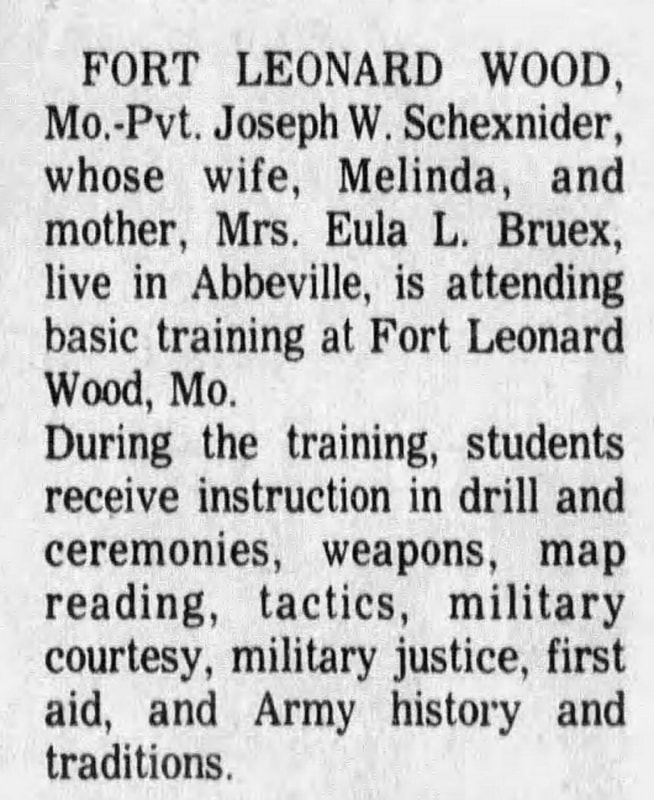
 RSS Feed
RSS Feed













